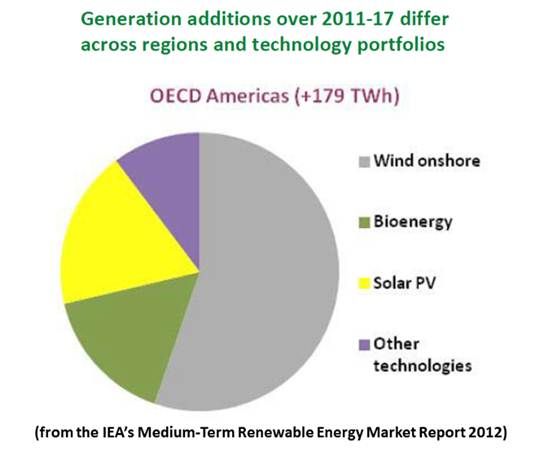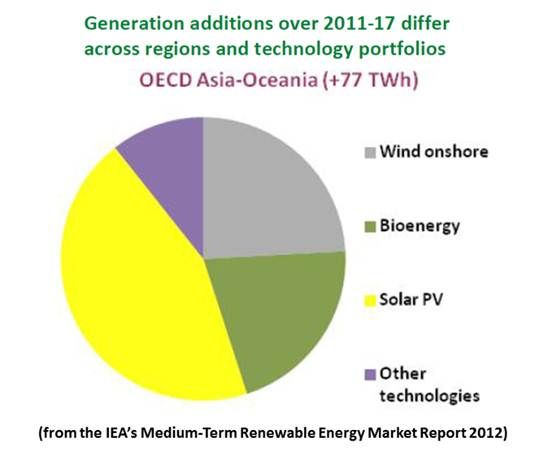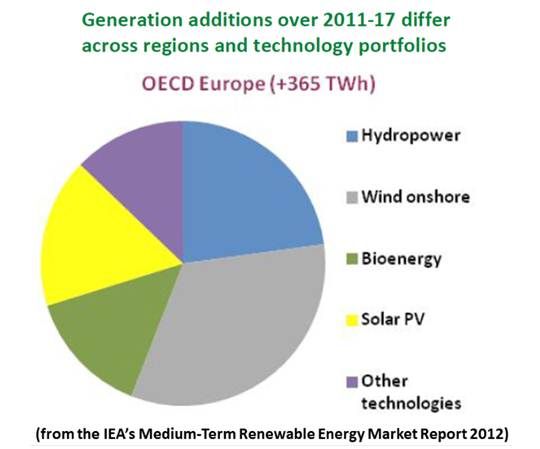The International Energy Agency (IEA), often skeptical about renewables in favor of fossil fuels, has just predicted a 40-plus percent increase in the world’s renewables-generated electricity over the next five years. The figure will go from 2011’s 4,540 terawatt-hours -- a rate that is itself 5.8 percent more than in 2010 -- to almost 6,400 terawatt-hours, a 5.8 percent annual growth rate over the five-year period.
“From 2011 to 2017 renewable electricity generation should expand,” the IEA’s just-released Medium-Term Renewable Energy Market Report 2012 reported, “by 1,840 terawatt-hours, almost 60 percent higher than the 1,160 terawatt-hours growth registered over the 2005-11 period.”
The increase will come as the result of a predicted addition by 2017 of 710 gigawatts of new renewables capacity.
Two-thirds of the growth will come from countries outside the Organization for Economic Cooperation and Development (OECD), which is made up of the established industrial nations. China will build almost 40 percent (270 gigawatts) of the new capacity.
The report considered eight electricity-generating renewable technologies: hydropower, bioenergy, onshore wind, offshore wind, solar photovoltaics (PV), concentrating solar power (CSP), geothermal and ocean power. It also included solar water heating. The conclusions came from the evaluation of fifteen key renewable energy markets which make up about 80 percent of renewable electricity generation
The first-ever medium-term report on renewable energy from the IEA noted the technologies are “maturing” as the result of “supportive policy” in OECD countries that has brought renewables to cost-competitiveness. “Renewable deployment is starting to transition,” the report observed, “from a phase in which it is more reliant on subsidy support to one in which projects are competing on their own merits.”

The increasing demand for electricity and increasing need for supply security have combined with the new economic competitiveness to drive growth that is expected to continue through 2017, especially in the United States (56 gigawatts), India (39 gigawatts), Germany (32 gigawatts), and Brazil (32 gigawatts).
Onshore wind will be deployed in at least 70 countries by 2017, the report predicted. There will be more than 100 gigawatts of solar PV and bioenergy in 45 countries by then. Geothermal and CSP will be deployed in fifteen countries and offshore wind in eleven countries.
Global investment in renewable electricity increased 19 percent in 2011 to $250 billion from 2010’s $210 billion. There was, the report noted, a drop in Q1 2012.
Renewable investment is expected to continue to grow because, according to the report, established technologies (hydropower, geothermal, onshore wind, solar PV) are presently at grid parity with new fossil generation in many places and costs are expected to continue to come down. Investors still see some renewables (offshore wind, CSP, the ocean energies) as risky, the report added.
Hydropower will lead growth with 730 terawatt-hours, the IEA report said. That will come largely in emerging economies.
Non-hydro growth will slow from 2005 to 2011’s 16.2 percent to 14.3 percent over the next five years. But the non-hydro renewables will add 1,100 terawatt-hours, about half in OECD countries and half in emerging economies.
Of that generation, wind power (onshore and offshore) should make the largest contribution to global renewables production through 2017, with a 16.7 percent total gain. “Onshore wind, bioenergy and solar PV see the largest increases,” the IEA reported, and “offshore wind and CSP grow quickly from low bases. Geothermal continues to develop in areas with good resources. Ocean technologies take important steps towards commercialization.”

Wind, the report predicted, should grow 15.6 percent (100 terawatt-hours) per year, 90 percent of it onshore. The 230-gigawatt 2011 world wind capacity is predicted to go to over 460 gigawatts in 2017.
Bioenergy (solid biomass, biogas, liquid biofuels, renewable municipal waste) is predicted to be 8.3 percent of the world’s renewable electricity generation capacity in 2017.
Solar technologies are predicted to be 4.9 percent of global renewable electricity in 2017. PV will grow, the report said, 27.4 percent (35 terawatt-hours) per year, going from 70 gigawatts in 2011 to 230 gigawatts in 2017. That growth is predicted to be led by China (32 gigawatts), the U.S. (21 gigawatts), Germany (20 gigawatts), Japan (20 gigawatts), and Italy (11 gigawatts).
CSP, by incorporating storage and being used in hybrid fossil plants, is expected to grow from 2011’s two-gigawatt capacity to 11 gigawatts in 2017, led by the U.S. (four gigawatts), Spain (one gigawatt) and China (one gigawatt).
Geothermal generation, the report predicted, could grow 4.2 percent (three terawatt-hours) per year and go from 2011’s 11-gigawatt capacity to fourteen gigawatts in 2017.
The cost of the technologies, the challenges of integrating them into the transmission system, and the availability of financing will be, the report concluded, the key factors affecting renewables’ continued growth. The European financial crisis, the shifting fortunes of politics and policy, and the price of natural gas are the key unknowns.
The outlook for realizing all of its brightest 2017 predictions, the report noted, was therefore “cautious.”




